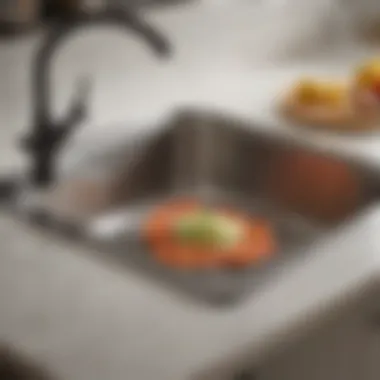Fresh Kitchen: Strategies to Eliminate Disposal Odors


Intro
Maintaining a fresh kitchen is essential for both hygiene and the enjoyment of cooking. One of the major obstacles homeowners face in their kitchens is the persistent odor that can emanate from disposals. Understanding the sources of these smells is the first step in tackling this issue. The unpleasant odors can arise from food scraps, standing water, and a lack of regular cleaning.
This guide presents effective strategies for eliminating disposal odors, allowing for a welcoming kitchen environment. By adopting a systematic approach, you can ensure your kitchen remains fresh and odor-free.
Understanding Kitchen Disposal Odors
Common Causes
- Food Residue: Leftover bits of food can accumulate and begin to decompose, leading to foul smells.
- Grease Build-up: Over time, grease can coat the disposal components, trapping odors.
- Standing Water: Stagnant water in the disposal can create a breeding ground for bacteria, exacerbating odors.
- Lack of Maintenance: Not regularly cleaning the disposal can lead to a decline in odors.
"Regular maintenance is key to preventing odors from developing in kitchen disposals."
Preventive Measures
To minimize odor growth, consider the following practices:
- Run Water: Always run cold water when using the disposal. This helps flush food particles away.
- Avoid Certain Foods: Some items like fibrous vegetables, fats, and starches can contribute to clogs and odors.
- Regular Use: Frequent use keeps the disposal from gathering stale food and grease.
Cleaning Techniques for Odor Elimination
Deep-Cleaning Strategies
Effective disposal cleaning can be achieved through the following methods:
- Ice and Salt: Pour ice cubes along with rock salt down the disposal. The ice cleans the blades while salt helps to scour the edges.
- Baking Soda and Vinegar: This classic combination helps neutralize odors. Pour half a cup of baking soda, followed by half a cup of vinegar. Let it sit for 15 minutes before rinsing with hot water.
- Citrus Peels: Grinding citrus peels, such as lemon or orange, can add freshness and leave a pleasant scent.
Maintenance Recommendations
Incorporating these practices can help maintain a fresh environment:
- Perform deep cleaning regularly, ideally once a month.
- Always run the disposal after use to prevent build-up.
- If odorsersist, consider checking for plumbing issues that may contribute to unpleasant smells.
With these strategies in place, tackling disposal odors becomes a manageable task. A clean and fresh kitchen enhances the cooking experience, ensuring that each meal is an enjoyable event.
Understanding Kitchen Disposal Odors
Understanding kitchen disposal odors is crucial for maintaining a pleasant and sanitary kitchen environment. Odors can signal underlying problems that, if left unchecked, can lead to more significant issues. This section explores the importance of recognizing and addressing disposal odors. By identifying the causes of these unpleasant smells, homeowners can take informed steps to keep their kitchens fresh.
Root Causes of Odors
Kitchen disposal odors stem from a variety of sources. One primary cause is the decomposition of food waste that becomes trapped within the disposal unit. Organic materials break down and produce gases that create foul smells. Additionally, food particles can accumulate in hard-to-reach areas, leading to bacterial growth, which intensifies these odors. Another cause can be grease buildup that coats the inside of the disposal over time. When grease combines with food waste, it can harden, creating a breeding ground for bacteria. Keeping this in mind can help focus efforts on proper disposal and maintenance practices.
The Impact of Food Waste
Food waste has a significant impact on kitchen odors. Many homeowners may not realize that what they toss down the disposal can lead to lingering smells. For instance, items such as eggshells, coffee grounds, and fibrous vegetables can contribute to blockage and odors. Furthermore, as food waste degrades, it emits volatile compounds that can fill the kitchen air with unpleasant smells. Understanding the effect of food waste can guide better disposal choices.
Environmental Factors Contributing to Odors


Environmental factors also play a role in kitchen disposal odors. High humidity levels can exacerbate decomposition, causing waste to break down more quickly and produce more gases. Similarly, poor ventilation around the disposal can trap odors in the kitchen rather than allowing them to dissipate. Even the type of plumbing system can contribute; older pipes may retain residue that contributes to odors. By recognizing these environmental factors, homeowners can take steps to improve air circulation and waste management, thereby reducing odors in the kitchen.
"Identifying the root causes of kitchen disposal odors is the first step towards creating a fresher and more hygienic cooking space."
In summary, understanding kitchen disposal odors helps set the foundation for effective odor elimination strategies. By assessing root causes, the effects of food waste, and environmental influences, one can make informed adjustments to waste disposal practices.
Preventive Measures
Preventive measures are essential in managing kitchen disposal odors effectively. By implementing smart practices, one can minimize the likelihood of unpleasant smells arising from food waste. A clean kitchen contributes to a healthier home environment and enhances the overall dining experience.
Proper Disposal Practices
Proper disposal practices are fundamental in reducing odors. Always ensure that food scraps are adequately separated and disposed of promptly. Using a garbage disposal effectively requires keeping it well-fed with water while running it to avoid buildup. Avoid fibrous vegetables or items which can tangle and block the system. It is wise to use a composting system if you produce a significant amount of waste. This offers a sustainable alternative while further decreasing the volume of waste processed in the disposal.
Regular Maintenance Schedule
Establishing a regular maintenance schedule is crucial for odor control. Routine checks of the disposal unit should be performed at least once a month. Inspect the blades and housing for any buildup. Scheduling a deep clean every few months can prevent long-term odor problems. Highlighting specific tasks, such as running baking soda and vinegar through the system, can keep odors at bay. Keeping a log of these activities can also provide insight into usage patterns and possible odor issues.
Keeping the Kitchen Clean
Keeping the kitchen clean is an ongoing battle that requires vigilance. This includes regularly wiping down surfaces, ensuring spills are addressed quickly, and maintaining cleanliness of garbage containers. Employing frequent cleaning methods, such as using safe disinfectants on countertops and floors, can remove residue that odors can latch onto. It is also vital to ensure the sink and disposal are free of food remnants. Consider using air purifying solutions to absorb any lingering smells.
"A clean kitchen is not just about looks; it's about health and comfort."
Incorporating proper disposal practices, maintaining a schedule, and keeping everything clean significantly mitigates odors, leading to a fresher kitchen environment.
Cleaning Techniques for Disposals
Cleaning techniques for kitchen disposals are crucial in maintaining an odor-free environment. Odors often arise from food waste stagnating in these units. Therefore, regular cleaning prevents buildup and ensures proper sanitation. This section explores various methods for cleaning disposals. Each technique offers unique benefits and considerations. Understanding these cleaning options is essential for every home chef and food lover.
Baking Soda and Vinegar Method
One effective way to clean your disposal is the baking soda and vinegar method. This approach is simple yet powerful. Start by pouring a cup of baking soda into the disposal. Follow this with a cup of vinegar. Allow the mixture to sit for about 15 minutes. The reaction between baking soda and vinegar helps to break down food particles and neutralize odors.
After the waiting period, turn on the disposal while running cold water. This flushes out the dislodged debris, leaving your disposal cleaner and fresher. It is an eco-friendly method, safe for both your disposal and the environment.
Ice and Salt Cleaning
The ice and salt cleaning method is another practical technique. Fill the disposal with ice cubes and add a generous amount of salt, preferably coarse salt for better abrasion. Turn on the disposal with cold water running. The ice acts as a grinding agent while the salt scrubs the interior surfaces of the unit.
This method is not only efficient in removing residue but also sharpens the blades of your disposal. Additionally, this technique can help prevent odors from food buildup. It is advisable to use this method regularly, as it promotes overall disposal health.
Citrus Peels Approach
Utilizing citrus peels is a natural and pleasant-smelling way to freshen up your disposal. Simply toss in peels from lemons, limes, or oranges and run cold water while activating the disposal. The oils in the peels work to eliminate odors while leaving a refreshing scent.
This technique is less abrasive and acts as a cleanser. Moreover, the citric acid helps to neutralize tough smells embedded in the disposal. It can also serve to encourage regular cleaning habits since this method feels more pleasant for those concerned about odor.
Commercial Cleaners


If home remedies are not effective, consider using commercial cleaners specifically designed for disposals. These products often include enzymes that break down food particles and fats, addressing stubborn odors more aggressively.
When using commercial cleaners, follow the manufacturer's instructions carefully. Ensure they are safe for your specific disposal model. Although these may be more costly than homemade solutions, they can effectively tackle deeply ingrained smells and residues that regular cleaning may not resolve.
In summary, the combination of baking soda and vinegar, ice and salt, citrus peels, and commercial cleaners presents a range of options for maintaining a fresh disposal. Each method has its strengths and serves various preferences. Finding the right technique for your kitchen will contribute to a cleaner and more enjoyable cooking experience.
Frequency of Cleaning
Maintaining a proper cleaning schedule for kitchen disposals is necessary to ensure a fresh odor-free environment. The frequency of cleaning directly influences hygiene levels in the kitchen. It helps prevent unpleasant odors from developing and reduces the risk of bacterial growth. Regular cleaning serves as a proactive measure to keep the disposal unit in optimal condition.
Set intervals for cleaning can vary based on usage. For busy kitchens, more frequent cleaning is advisable. In contrast, less active kitchens might require less regular attention. The key is to adapt to individual needs while ensuring that cleaning does not become an afterthought. This consistent care fosters a pleasant cooking and dining atmosphere.
Recommended Intervals for Cleaning
It is beneficial to establish a routine for cleaning the disposal unit. Here are some suggested intervals:
- Weekly Cleaning: For households that frequently use the disposal, a weekly cleaning routine can be effective. This helps in preventing buildup of food remnants, which lead to odors.
- Bi-weekly Cleaning: For moderate use, every two weeks may be sufficient. This schedule strikes a balance between maintaining sanitation and managing time effectively.
- Monthly Deep Cleaning: Regardless of the regular cleaning interval, a more thorough monthly cleaning should be incorporated. This involves using specific techniques to address any persistent odors more effectively.
By adhering to these intervals, homeowners can significantly reduce the chance of unwanted disposal odors.
Signs That Cleaning Is Needed
Recognizing when the disposal unit needs cleaning is crucial. There are several clear indicators that can signal the need for a thorough cleaning:
- Unpleasant Smells: A sudden increase in odors coming from the disposal is often one of the first signs it needs attention.
- Slow Draining: If water drains slowly through the disposal, it may be a sign of buildup. Cleaning is necessary to prevent clogs.
- Visible Debris: When looking inside the disposal, visible food remnants or debris can indicate that cleaning has not been sufficient.
- Dishwashing Issues: If the dishwasher seems to be backing up or there are strange noises during operation, this may point to a problem with the disposal and the need for cleaning.
Being attentive to these signs ensures that the kitchen remains a clean and welcoming space. Consistent cleaning habits lead to long-lasting freshness for all who enjoy being there.
Identifying Persistent Odors
Identifying persistent odors in the kitchen disposal unit is a crucial step towards maintaining a fresh cooking environment. These odors can linger and worsen over time if not addressed properly. Ignoring them may lead to an unpleasant atmosphere and could also indicate underlying issues that require attention. By understanding how to identify these odors, homeowners can take appropriate actions to eliminate them and enhance their overall kitchen experience.
Assessing the Disposal Unit
To assess the disposal unit effectively, start by checking for anomalies. Run a short cycle with water to listen for unusual sounds, which might indicate damage or blockages. If the unit emits a foul smell, it could mean food particles are trapped inside. As a regular practice, examine the disposal for any lingering residue. Use a flashlight to look into the unit, and if you see debris, it’s time for a thorough cleaning.
Additionally, consider the condition of the disposal's rubber splash guard. Over time, it may harbor residue that leads to odors. If it seems worn out or excessively dirty, it’s best to clean it or consider replacing it. Regular assessments can help catch potential problems before they escalate, paving the way for a cleaner and fresher kitchen.
Inspecting Associated Plumbing
Inspecting the plumbing associated with the disposal is equally vital. The connections leading to and from the disposal could be a source of odor if they are compromised. Look for signs of leaks, which can allow food particles to settle and decompose, contributing to bad smells.
Check for clogs in the pipes that may be hidden from view. Running a drain cleaner through the pipes can help if slow drainage is observed. In cases of persistent odors, using a camera inspection service might be necessary to visually confirm any deep-seated issues within the plumbing system.
"Regular inspection not only helps eliminate current odors but also prevents future issues, making it a wise practice for homeowners."
By following this guideline, one can keep track of any changes that might indicate an odor problem. Keeping both the disposal and associated plumbing in check will go a long way in ensuring a pleasant kitchen ambiance.
In Case of Clogs


Dealing with clogs in the kitchen disposal unit can be a frustrating experience. This section will address the significance of understanding clogs, their causes, and the best ways to resolve them. Kitchen disposals are essential for managing food waste effectively, but when they become clogged, they not only fail at their function but can also create unpleasant odors. Properly addressing clogs ensures functionality and enhances hygiene within the kitchen environment.
Understanding the Cause of Clogs
Clogs often arise from the accumulation of food particles, grease, and foreign objects trapped within the disposal unit or plumbing. Some common reasons for clogs include:
- Starchy Foods: Items like pasta and rice tend to swell and can create blockages.
- Grease Buildup: Over time, fats can solidify in pipes, leading to obstruction.
- Hard Materials: Bones, shells, or fibrous vegetables can cause physical blockages.
- Insufficient Water Flow: Inadequate flushing can leave waste stuck in the disposal.
Recognizing these causes is essential for preventing future issues. Regular attention to disposal practices can help avoid clogs from occurring in the first place.
Safe Methods to Clear Clogs
Once a clog occurs, it is imperative to clear it safely without damaging the disposal unit. Here are some effective methods you can employ:
- Plunger Technique: Use a plunger to create suction. Ensure there is enough water in the sink to cover the disposal. This method can help dislodge minor clogs.
- Manual Check: If safe, you can inspect the disposal for visible obstructions. Turn off the power first before inserting a tool to dislodge any trapped debris.
- Baking Soda and Vinegar: A mixture of baking soda followed by vinegar can help break down grease. Allow it to sit for a few minutes before flushing with hot water.
- Hot Water Flush: Gradually pouring boiling water can help dissolve fatty clogs, especially if done consistently over time.
Always remember to follow safety protocols to prevent injuries.
Employing these methods when faced with clogs will not only restore your disposal's functionality but can also help avoid potential odors caused by stagnant waste.
Long-Term Solutions
Maintaining a fresh kitchen environment requires a strategic approach to eliminating disposal odors. Long-term solutions play a crucial role in ensuring sustainability and effectiveness in odor management. These solutions not only address current issues, but also prevent future problems from emerging. The focus here is on two key areas: investing in quality disposal units and adopting healthier waste practices. By addressing the fundamental aspects of waste disposal and management, homeowners can significantly enhance their kitchen's aroma and hygiene.
Investing in Quality Disposal Units
When it comes to effectively managing disposal odors, quality matters. Investing in a high-grade kitchen disposal unit can make a significant difference. These units are designed to handle various types of food waste more efficiently. Look for features such as:
- Powerful Motor: A strong motor can grind food waste into smaller particles, reducing the chances of odors forming.
- Durable Construction: Stainless steel components resist corrosion and wear. They are likely to last longer and perform better than cheaper alternatives.
- Advanced Grinding Technology: Some disposals use multi-stage grinding, which can help with finer waste breakdown, minimizing smell.
- Noise Reduction Features: A quieter unit not only provides a more pleasant kitchen environment but can also indicate a higher quality product.
By choosing a dependable disposal unit, consumers are making a proactive choice that promotes longevity and effectiveness. It is also important to follow the manufacturer's guidelines during installation and maintenance.
Adopting Healthier Waste Practices
Beyond improving disposal units, adopting healthier waste practices is essential. This ensures that waste is handled properly, limiting odor production and promoting a cleaner kitchen. Here are several practices to consider:
- Separate Compostable Waste: Use a compost bin for organic waste. This minimizes the load on the disposal unit and keeps smell under control.
- Avoid Problematic Foods: Some foods, like fibrous vegetables and starchy substances, can contribute to clogs and odors. Being mindful of what you dispose of can greatly enhance your kitchen’s ambiance.
- Regularly Empty Bins: Waste bins should be emptied frequently. Rotted food remains produce unpleasant smells swiftly. Prompt removal helps to maintain freshness.
- Store Food Properly: Ensuring food items are sealed correctly can reduce the occurrence of leaks and spills.
Incorporating these practices requires discipline, but their benefits are significant. It contributes to a better overall kitchen experience.
By investing wisely and practicing healthy waste management, homeowners effectively navigate the challenge of kitchen disposal odors and foster a more pleasant cooking environment.
Adopting both of these approaches contributes to a holistic strategy in odor management. Long-term solutions are an investment toward achieving a consistently fresh kitchen.
Closure
In this article, we have explored various strategies to address the persistent issue of kitchen disposal odors. The significance of understanding disposal odors lies in its direct impact on both hygiene and overall cooking experiences in the kitchen. An unpleasant smell can deter people from enjoying their culinary environment, affecting how they feel about cooking and eating in their homes.
Summary of Key Points
Several key elements emerged through the discussion. Firstly, identifying the root causes of disposal odors is essential; it includes food waste buildup, the actual functioning of the disposal unit, and external environmental factors. Preventive measures, like practicing proper disposal methods and maintaining a regular cleaning schedule, play a crucial role in preventing odors from becoming a problem. The cleaning techniques discussed, such as using baking soda and vinegar or citrus peels, offer easy yet effective solutions. Furthermore, understanding the frequency for cleaning and recognizing the signs of persistent odors can guide effective maintenance.
Encouragement for Ongoing Maintenance
It is vital for homeowners to view ongoing maintenance not only as a necessity but as an investment in their kitchen's comfort and cleanliness. Establishing a routine that includes regular cleaning and checking disposal functionality can greatly reduce the occurrence of unpleasant odors. Committing to this effort ensures a fresher kitchen, enhancing the overall dining and cooking experience for everyone. \n Keeping a checklist of cleaning activities can be a straightforward method to stay on top of maintaining kitchen hygiene. By dedicating a little time regularly, one can cultivate a pristine kitchen atmosphere.















